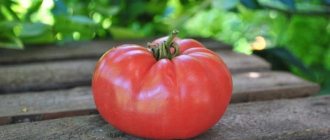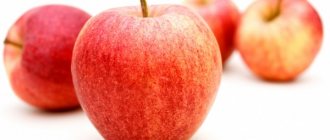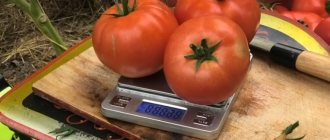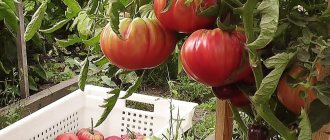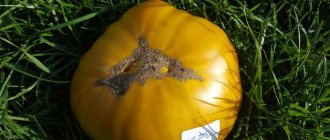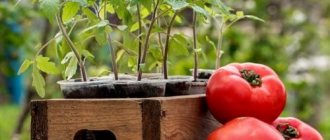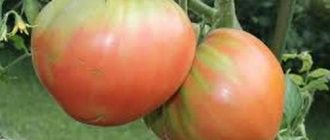The Chinese pink tomato is a popular hardy variety. The highlight is the meaty, huge tomatoes with a rich, aromatic taste. The tomato is valued for its tolerance to temperature changes during the day and night, and its resistance to infectious pathogens.
| Height | Landing location | Ripening time | Fruit color | Fruit size | Origin | Fruit shape |
| Tall | Greenhouse | Early ripening | Pink | Large | Variety | Heart-shaped |
Characteristics of fruit formation
The company presented the variety as large-fruited. The tomatoes are flat-round, fleshy, and moderately elastic.
But those who have already managed to purchase seeds and grow them describe the shape of the fruit as classic heart-shaped. The fact that this is a mismatch is obvious, so you can’t count on full compliance.
There is greater agreement with the color of the tomato - it is pink, as stated in the name of the variety. The fruits do not have a green spot on the stalk and their color is uniform.
Packers promise that the “Chinese Pink” tomato variety has excellent taste, balance of acids and sugar content, as well as a pleasant pulp texture.
However, vegetable growers do not share their opinion and talk about mediocre taste and lack of aroma.
Another stumbling block was the size of the tomatoes. "Sedek" generously claims a weight of 500-700 grams. not so generous and they say the weight is 300 g. However, gardeners who have tried to grow “Chinese Pink” claim that the fruits hardly reach 200 g.
In addition, there were differences in yields. Firms do not name the commodity output in numbers, limiting themselves to the word “yield”. Vegetable growers, without lying, talk about very small quantities of fruits with uneven indicators.
Rules for growing seedlings
In order for the yield to be high, seedlings must be grown independently. To do this, you should follow simple rules of agricultural technology.
Features of cultivation:
- First, the planting material must be dipped in a solution of potassium permanganate for 30 minutes, then the seeds must be dried until they become free-flowing;
- Prepare the soil, water with warm water and make shallow furrows;
- Plant the seeds and cover the box with glass (you can use cling film);
- Once a week, the glass should be removed and the seeds should be sprayed with water at room temperature;
- After the sprouts appear, the glass is removed.
The second important stage is planting the seedlings in a permanent place. The soil should be mixed with cow manure or chicken droppings. Make shallow holes and plant seedlings. They must be covered at night until the temperature reaches above zero.
It is recommended to apply mineral and organic fertilizers to the bushes throughout the season. The first feeding is carried out during the period of active growth of tomato bushes.
The second feeding is carried out during the formation of ovaries and flowering. The bushes can be watered with a solution of mullein and superphosphate (1 kg of mullein and 25 grams of superphosphate). Plants can also be watered with a solution of potassium sulfate (5 g) and nitroammophoska (50 g) per 10 liters of water.
Subsequent feedings are made based on the condition of the bushes. If they are weak and frail, then fertilization should be continued. If the tomatoes begin to grow leaf mass, and the number of fruits decreases, then you need to stop feeding the bushes.
https://youtube.com/watch?v=xa0h4gUfI5c
Purpose of the variety
“Sedek” prescribes the purpose of the variety as a salad variety, but “Seeds of Altai” claims that the variety is for universal use.
Considering that “Chinese pink” tomatoes should be large-fruited, then they are intended for salad purposes. However, if there is excess product, you can always process it into sauce, tomato juice, lecho or ketchup. Considering the color of the tomato, it becomes clear that the product will not have a marketable appearance during processing, since pale pink does not quite match the color of tomato products. Therefore, you need to add red tomatoes to them.
Judging by the reviews of those who have already grown, this variety does not produce a surplus, since the yield is not high.
Agricultural technology
Pink elephant tomato seeds should be sown in the first ten days of March. They do not require special preparation; they can be kept in a manganese solution for no more than 15 minutes. This procedure applies to seed collected independently. By the way, the best germination is demonstrated by seeds collected more than 2 years ago.
It is better to sow immediately in separate pots; you can use peat ones. The soil is prepared from garden soil, humus, sand and ash.
Shoots should be expected no earlier than 7-12 days. For better germination, the pots can be covered with glass or film.
For better germination, the pots can be covered with glass or film
Already at this stage, you can resort to hardening: leave the pots until the shoots appear at a temperature of no more than 16 degrees, and then place the seedlings in a room with a temperature of 20-25 degrees.
The seedlings should be watered 2 times a week and only with warm water. You can add a little growth stimulant to it, for example, Epin.
On a note! In the phase of two true leaves, complex mineral fertilizer is applied. You can also apply nitrogen fertilizers.
Before planting in the ground, it is necessary to harden the seedling material again by taking it outside in sunny, warm weather for 5, then 7, and so on up to 15 minutes.
Seedlings must be exposed to sunlight
Advantages of the variety and alternative option
It is difficult to judge the advantages and disadvantages of re-grading.
Reading the reviews, it becomes clear that the majority of vegetable growers included the variety in the list of “Those varieties that I will not plant.” There are some gardeners who still have doubts and believe that the variety needs special conditions, which they supposedly failed to create, which is why the “Chinese” did not show productivity.
There is an opinion among experienced gardeners that the “Chinese Pink” variety is nothing more than the legal agro variety “Chinese Souvenir”. The only thing that remains unclear is why to make a re-sort out of this.
"Chinese souvenir" has the same face:
- early ripening;
- gives large fruits;
- beautiful pink color;
- indeterminate;
- suitable for fresh consumption;
- resistant to Fusarium fungal infection.
Reviews from gardeners
The popularity of such species began to increase due to their positive properties.
The characteristics of an individual variety will allow you to understand whether it is suitable for cultivation in certain conditions or not. Descriptions of popular varieties will help the summer resident choose the appropriate species.
Early
A common variety of Chinese tomatoes. Summer residents grow it for the following reasons:
- high field health;
- undemanding to garter, bushes barely reach 0.5 m;
- large-fruited, weight reaches 200 g, flat-round, red tomatoes;
- Tomatoes are stored for a long time, the taste is excellent;
- the dense peel makes it easy to transport them over long distances;
- use for preparing tomato juice at home and industrially.
Recommendations for formation - it is advisable to keep the bushes in 2 trunks. This way, the plants get the maximum possible yield. They are grown in closed ground; only in the south do vegetable growers plant the variety in open ground. Early tomatoes are afraid of low night temperatures. Summer residents advise tying the crop to stakes so that the fruit clusters do not come off due to the large weight of the tomatoes.
Ripens within 85-95 days. Raspberry tomatoes are round in shape. With proper care, the weight reaches 250 g. Plants are resistant to common crop diseases. In addition, they easily tolerate stressful growing conditions.
The fruits ripen simultaneously, with an average of 5-7 pieces per cluster. Summer residents advise forming into 2 stems. The remaining stepsons are removed. Due to its high cold resistance, the Chinese souvenir is planted in regions of risky agriculture in unprotected soil.
Chinese princess
The ripening period for the fruits of the plant is 115-125 days after planting. The fruits are of an unusual color; when ripe they are greenish-brown. Compliance with cultivation requirements and timely implementation of agricultural techniques allows you to obtain fruits weighing 0.5 kg. The average fruit weight is 0.25 kg.
The bushes are tall, reaching 1.7 m. Formation of 2-3 stems is required. After the 7-8th brush is formed, the growth point is removed. It is grown in regions with hot, dry summers due to its ability to tolerate high temperatures.
The main creators of new tomatoes were two companies called Seeds of Altai and Siberian Garden; these companies create new types of tomato plants every year, after which they put them on the general market. I would like to say that the varieties were bred not only for planting in greenhouses, but also for transplanting them under the open sky into the ground in the garden.
The best tomato varieties from Siberian selection
To begin with, it is worth considering the most productive tomato seeds of Siberian selection, since they are the most popular among gardeners. Many people set the main goal to get the largest harvest, for this reason we can recommend several excellent varieties of tomatoes that will produce a large number of fruits during the fruiting period.
You can increase the yield of any tomatoes if you use a plant growth activator.
Pride of Siberia
Looking at the name, you can understand that this variety should really be very productive, and so it is, its name is completely true. The fruits on the plant appear quite early, the bush itself is quite tall and can reach a height of about one and a half meters, sometimes even more, without a doubt it will need a garter.
When fruiting, it bears large and tasty round-shaped fruits, they have a bright and rich red color, and often reach nine hundred grams in weight. The taste of ripe vegetables is very pleasant, but due to their large size they are used exclusively for making salads. No more than five bushes of such a plant are planted per square meter; in addition, tomatoes require mandatory fertilizer, which is produced according to the described scheme.
Siberian abundant
This is the second most popular variety, which also fully justifies its beautiful name; during fruiting, the fruits are actually collected in great abundance; from just one bush, a gardener can get up to six kilograms of ripe and juicy tomato fruits. Each fruit is quite large; tomatoes can weigh up to two hundred grams, but most often there are fruits measuring one hundred and fifty grams in weight.
Tomatoes have a bright shade of red when ripe, but when the fruits reach the point where they need to be picked from the bush, the vegetable takes on a bright crimson color. The pulp of each fruit is quite dense, but at the same time juicy; for this reason, such tomatoes are often used to create sauces and homemade tomatoes. The Budenovka tomato variety is very popular among gardeners.
The bush can grow up to one hundred and seventy centimeters in height, the fruits ripen quite early, and each bush can produce about seven clusters that bear fruit. If outer flowers begin to form on each branch, it is recommended to remove them; this will help the remaining fruits to ripen in a shorter time, since the plant will spend all its energy on the finished tomatoes.
King of Siberia
These tomato seeds of Siberian selection are the most productive and produce ripe fruits a little later than the previous varieties, for this reason they are considered mid-ripening, but the advantage of this variety is that tomatoes can easily grow in open ground in the garden, which is very convenient for those gardeners who do not have greenhouse for growing vegetables.
This variety bears very large and tasty fruits; most often you can see tomatoes measuring four or five hundred grams, but in some cases you can come across tomatoes weighing eight hundred or even nine hundred grams. Each tomato has a bright yellow hue, and their shape is more like a heart. Planting can be done after the sixth and seventh leaves have sprouted on the seedlings; you will also have to wait for the formation of a flower cluster, which should bring a harvest. If you count by days, then seedlings are planted sixty days after sowing the seeds in the ground.
Chinese disease resistant
These tomato seeds of Siberian selection are the most productive, but at the same time they are new on the market; they were bred not so long ago, but many gardeners have already appreciated them. Plants tolerate various diseases well, as they have natural immunity to them, and also bear their first fruits quite early, which is why they have become so interesting to summer residents.
Bulls-eye
This is another wonderful variety from breeders, which was bred quite recently, although the name is a little strange, but such tomatoes ripen in the shortest possible time, while the bush shows the highest level of productivity, which is a big advantage of the tomato plant in such climatic conditions.
Each fruit has a shape similar to cherry berries; on each branch, from ten to forty beautiful tomato fruits can form; the fruits themselves are light in weight, only thirty grams, for this reason they are excellent for salting in jars in their entirety. The bushes grow up to two meters, for this reason they must be tied up, but it is best to grow them in a greenhouse.
READ MORE: Strawberry Tristan reviews. Strawberry Tristan f1: description of the variety, growing features
Siberian surprise
These tomato seeds of Siberian selection are the most productive, have a medium-early period of fruit ripening, about ten tomatoes can form on each cluster, and the bushes are quite fertile. Each plant can grow up to one hundred and twenty centimeters in height; it is very important to carry out pinching of this type of tomato; if this procedure is not done on time, then you will not have to expect a large yield from the variety.
Siberian apple
This type of tomato also has a medium-early fruit ripening period; after ripening, the vegetables have a delicate pearl-pink hue. The bushes grow in height to no more than one hundred and eighty centimeters, the fruits themselves are very fleshy and also have sweet pulp, for this reason they were called “apple”. This variety is excellently grown in greenhouses, and the fruits themselves have a beautiful appearance and are well stored for a long period of time.
- Nikolai from Nizhny Novgorod. Last season I planted a Chinese souvenir in my own temporary greenhouse. At the end of June I tried my first tomato. The flesh is a little dense for my taste. I'm happy with the harvest. I collected more than I expected, although the summer was cold.
- Natalia from the Moscow region. I have been growing tomatoes in my garden for a long time. The pink varieties are my favorite. On the advice of a neighbor, I planted the described tomato in a greenhouse. In mid-summer I removed 2 buckets from several bushes. The hybrid has a rich taste and a strong aroma. Most of it was eaten fresh. The rest was used for juice.
- Dmitry from Voronezh. I have been growing tomatoes for sale for 4 years. I give preference to early, productive varieties and hybrids, which I plant in a permanent greenhouse with a polycarbonate coating. I liked the presented tomato. It forms an ovary well under any conditions and has a marketable appearance.
A Chinese souvenir from those varieties that can be recommended for growing in private household plots and on farm plots. In any weather, the hybrid will not let you down and will generously give you a harvest.
Features of cultivation
All tall tomatoes are grown by seedlings, and “Chinese” ones will be no exception.
The sooner you plan to plant a tomato in open ground or a greenhouse, the sooner you need to sow the seeds.
However, early crops will grow without additional lighting with phytolamps. Therefore, it is necessary to either provide lighting or choose the end of March as the sowing time.
Regions for cultivation
Sowing time naturally varies by region. Since the packers did not bother to register this point, sowing must be carried out in accordance with the following standards:
- The age of seedlings at the time of planting in the ground should be within 55-65 days. Therefore, if in your area frosts are not possible only after May 20, then you need to sow the seeds on March 10-15. If soaking seeds is practiced, then the deadline can be postponed to March 20-25;
- Seedlings should have 6-7 well-developed leaves. To achieve such results, it is necessary to select a universal, nutritious soil, or carry out regular fertilizing during the seedling period;
- The seedlings must have time to form an excellent root system. This requires picking, in the phase of 2 true leaves, into an individual container.
Resistance to pathogens
Since the companies selling the seeds did not indicate the resistance of the variety, and there are also few reviews from vegetable growers on this matter, it is necessary to process it.
There are also rules for preventive treatments:
- the beginning of spraying should coincide with the formation of the first ovary;
- You cannot use the same systemic drugs year after year, this causes the microflora to become addictive and they become ineffective;
- it is necessary to alternate drugs throughout the season, selecting them from different groups according to the current basis;
- the frequency of treatments is selected depending on weather conditions, but at least once every 20 days;
- During the harvest period, a preparation is selected that has the shortest waiting period from the moment of spraying to the moment of harvesting the fruit.
Complex of care works
Caring for varieties of pink tomatoes is aimed at maintaining productivity and presentation. Gardeners carry out several preventive measures.
Surface crack protection
If the soil is not sufficiently moistened, cracks appear on the surface of the vegetables. To prevent them, regularly, 2 times a week, water with warm water. Irrigate only the root system, avoiding access to the leaves and trunk. Potassium permanganate and ash are used to enlarge plants. Water according to the following scheme:
- before the flowers begin to form, add 3-4 liters of water per planting meter;
- During the period of fruit appearance, add up to 12 liters of water to the site.
It is recommended to add water in small quantities or using drip irrigation. In greenhouse conditions, day and night temperatures are controlled. During the period of return frosts, a bucket of coals is placed in the structure. In hot weather, hang a thick cloth moistened with water.
Treatment of bushes against late blight
Pink tomato varieties are susceptible to late blight. To eliminate the disease, perform:
- treatment with mustard-copper solution. For 10 square meters you will need 4 tbsp. l. mustard diluted with water. The solution is combined with 100 g of vitriol diluted in a liter of water. For 10 liters you need to add sodium carbonate, ammonia;
- spraying after 14 days with special preparations. A tablet of the product is diluted in 10 liters of water.
In the entire line of rose crops, De Barao and Magnat show resistance to late blight.
Top dressing: application rules
Large-fruited plants require proper nutrition. The following are used as fertilizers:
- mineral phosphorus fertilizers - for varieties in seedling condition;
- organic matter - it is poured into planting holes. You will need a mixture of compost and ash;
- complex means. Mullein with water in proportions 1:10 and 1 tbsp. l. superphosphate is applied 14 days after planting the seedlings. The second and third feedings are carried out after a similar time.
During the ripening period, bushes need calcium. Use a glass of wood ash dissolved in 10 about water. If the sheets have lightened, add urea, and remove the purple tint with superphosphate. Chicken manure is used to increase productivity. Despite the meticulous care and labor-intensive nature of planting, pink tomato varieties attract gardeners for their productivity. Large fruits with healthy vitamin composition will delight the summer resident with excellent taste characteristics.
